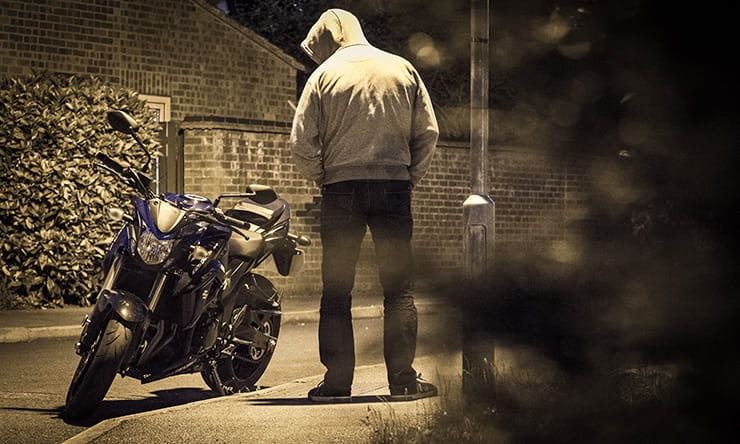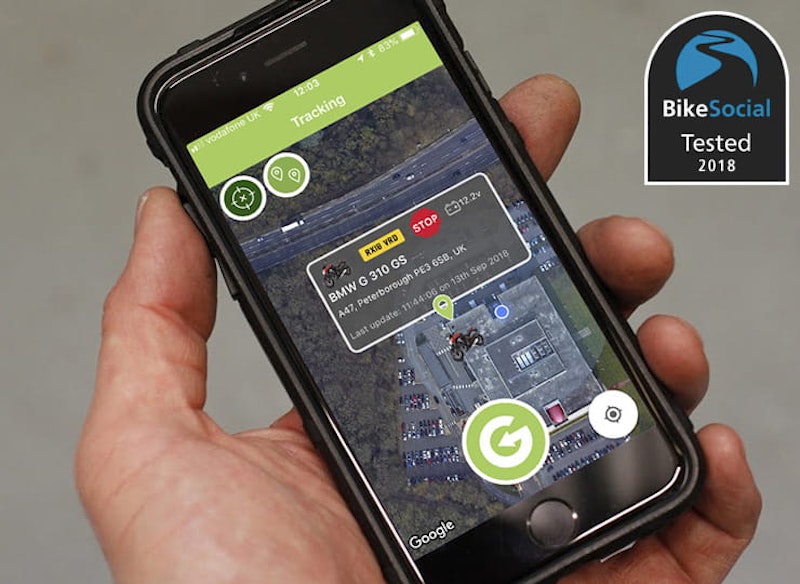Tested: SmarTrack MotoTrak Maxi motorcycle tracker review
By John Milbank
Consumer Editor of Bennetts BikeSocial
14.09.2018
Date reviewed: September 2018 | Tested by: John Milbank | Price: £299 including fitting | http://smartrack.eu
Your first line of defence in motorcycle security should always be a chain and lock or other solid device – you can read our destruction tests here. But a determined thief though could still take your motorcycle or scooter, so having a quality tracker fitted massively increases the chances of getting your bike back… It could also lead to the arrest of the criminals.
SmarTrack’s MotoTrak Maxi is a professionally-fitted motorcycle tracker from Global Telemetrics.
Features
MotoTrak Maxi is a Thatcham-approved Category 6 device, which means it has tracking when in alert mode, a battery back-up, two-way communications with a control centre, ignition-off illegal movement detection and street level mapping.
The device costs £299, but that includes fitting. It can be transferred to another vehicle later, though you will need to pay for the labour.
A subscription with 24-hour monitoring by the Secure Control Centre costs £149 per year, though you can also choose a ‘duration of motorcycle ownership’ subscription – with a £399 one-off charge, you’ll be covered for as long as you own that bike.
SmarTrack staff will liaise with the police once given a crime number (all monitored trackers require the police to be notified first), though the company also works with a specialised vehicle repatriation contractor, which can sometimes assist the police in more difficult situations.
This SmarTrack device uses GPS and GSM/GPRS to locate a stolen bike across Europe.
An Android/iOS app allows you to see where your bike is on a standard map, satellite, hybrid or terrain view, as well as the current voltage of your machine’s battery.
Location updates are sent every hour via GSM.
A three year warranty is included.
Fitting
SmarTrack MotoTrak Maxi must be fitted by a professional installer, but they can come to you at home or work, or you can arrange to take it to an approved centre. Julian, the engineer who fitted this test device, hid the discreet box away well (we won’t show what it looks like), and incorporated the wiring into the bike’s loom effectively; this is important as it’s vital crooks take as long to find a tracker as possible – leaving it under the seat is the worst thing that can be done.
Once installed, I immediately received the insurance certificate, along with instructions on how to install the app to my phone.
The SmarTrack app allows you to check the location of your bike, and the battery voltage
Day-to-day use
The MotoTrak Maxi is a completely automatic system that never really interferes with your use of the bike. Unlike some other tracking systems we’ve tested, there’s no option for vibration alerts – this means you won’t get a text message if someone fiddles with the machine, but you don’t need to remember to turn it off when you’re washing the bike.
The device checks in every hour with its location, or when it senses vibration – this means it’s relatively power-hungry, though it’s accentuated by the small battery of the G310GS I’m testing it on.
I left the bike in the garage while on holiday, and looking at the data from the tracker, I can see the battery lost about 0.1Volts each day. After two weeks, the bike fired up, but turning it off, then leaving it for two more days, there wasn’t quite enough juice left in it.
I also stored the bike in a shipping container for several days, and here the battery was completely flattened, as the SmarTrak was trying to send increasingly large amounts of data every hour, but failing due to being in a metal box.
Most modern motorcycles pull some power even at rest, and fitting a tracker increases the likelihood of you needing to use a maintenance charger. Because the Maxi is updating itself hourly, you will see more of a drain compared to devices that wake only when they sense vibration.
Your bike’s battery voltage can be quickly seen in the app or on the desktop web portal, though you can’t set up an alert to warn you if it gets low.
The web portal allows you to see your bike on Google maps
The iOS/Android app is very simple to use but quite basic, only showing location and battery level. The web portal is more full-featured, and you can even see the bike in Google Street View, which is a very neat feature as it overlays a motorcycle icon to the 3D view.
Logging in via the desktop computer allows you to see the status of the bike at least every minute (often every few seconds) when the ignition’s on – here you’re given the location (you can click to see it on a map), the time of day, speed, direction, distance travelled, battery voltage, ignition status and signal strength. You can also click to add a geofence at that location, which would send you an email when it left that position (radius can be set between 0.1 and 700 miles).
Ultimately, the functions of the SmarTrack software are more geared towards fleet operators, allowing them to be notified if a driver leaves an area or exceeds a given speed. For the average motorcyclist, the lack of transport modes can cause unwanted calls if you don’t remember to ring the control room and notify them, and I would have liked the option of an early-warning SMS when vibration is detected with the ignition off.
Every piece of data recorded can be checked through the web portal
Theft test
All our tracker tests are conducted in the same way – we don’t tell the manufacturer when we intend to perform a mock theft, and while we won’t waste police time to raise a crime number, we expect the device and operations centre to demonstrate the full service.
Level one: Stolen and left in street: Notification of the bike being stolen comes from the call centre, and with the bike out in the street (with a clear view of the sky), accuracy was around 10 metres.
This is a common situation, as motorcycles are very often pushed away using a moped, then left (often chained and covered) for a day or two, just in case they have a tracker.
In this case, the police would most likely find your bike very quickly and a PCSO or other officer could be with it until it was recovered.
Level two: Stolen and hidden in a building: Accuracy within a building depends on the construction, but I’ve found it’s still typically around 10-15 metres. The police, or the investigating contractor, would likely find further evidence if needed, for instance in a row of lock-ups.
The strength of the GPS signal will depend on the position of the device on your bike – in my case it’s under the tank. Some trackers use a remote GPS antenna, which can greatly increase the signal strength, though it does need to be well hidden.
In our theft test, the bike was successfully tracked, despite being in a van
Level three: Stolen and hidden in a shipping container: This is our toughest test. On the day we pushed the bike straight into a large van (with a steel bulkhead), and drove it to our test location, where it was quickly unloaded (in the open), then pushed into the solid container.
The response from the call centre was a little slower than previous tests – 15 minutes after the bike was driven away – but it had been automatically tracking the whole time; the agent who called was able to see where it had been, and where it was left.
Tracking along the road while inside the van was accurate, which would help the police if the bike was still in transit. When unloaded, the data showed the approximate position the bike was in just before it entered the shipping container, then – as with other devices – the signal was lost. Any officer or investigator attending the site would be in a good position to work out where the bike had gone.
Bike jacking
If you were unfortunate enough to be pushed off you bike and have the thief ride it away with your keys, the SmarTrack wouldn’t be able to detect this automatically, but the app would still show its location. You could call the control centre (with the crime number, which you can get quickly) and have them take over the tracking, liaising with the police and hopefully catching the criminals.
Verdict
The accuracy of the SmartTrack’s GPS isn’t as quite as pinpoint as some others we’ve tested, but it’s still good, and it’s likely that other clues would alert the police or investigator to the location of a bike (chop shops for instance have some very real ‘tells’).
The lack of an RF beacon means that location in a tower block (for instance) can be tricky, though again, there could be other evidence that would lead to the recovery of your bike.
Ultimately, the inclusive fitting cost, lifetime subscription option and good recovery support make the SmartTrak Maxi worth considering as an effective tracking device.
For more information on tracking systems, click here.

